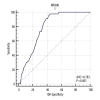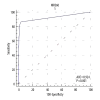Intraoperative Renal Near-Infrared Spectroscopy Monitoring as a Predictor of Renal Outcomes in Cardiac Surgery
- PMID: 40121520
- PMCID: PMC11948832
- DOI: 10.12659/MSM.947462
Intraoperative Renal Near-Infrared Spectroscopy Monitoring as a Predictor of Renal Outcomes in Cardiac Surgery
Abstract
BACKGROUND Acute renal failure (ARF) is a critical complication following open-heart surgery, significantly impacting morbidity and mortality. This study aimed to evaluate the association between intraoperative renal near-infrared spectroscopy (NIRS) findings and postoperative ARF in 357 patients undergoing cardiac surgery with cardiopulmonary bypass (CPB). MATERIAL AND METHODS This prospective study included 357 patients undergoing open-heart surgery with CPB. ARF diagnosis was based on KDIGO criteria. NIRS sensors were placed bilaterally at the T12/L2 level under ultrasound guidance, and renal oxygenation (rSO2) values were continuously monitored intraoperatively. Patients were categorized into ARF and non-ARF groups for comparative analysis. RESULTS ARF developed in 12.3% (n=44) of patients. ARF patients were older (p=0.024) and had longer surgery (p<0.001), CPB (p=0.004), and aortic cross-clamping durations (p=0.013). They required more blood products (p<0.001) and intra-aortic balloon pump support (p=0.027). Intensive care unit stays were significantly longer in ARF patients (p=0.036). NIRS analysis showed significant rSO2 reductions in ARF patients. Time spent with rSO2 below 80%, 70%, and 60% was a strong predictor of ARF. Receiver operating characteristic (ROC) analyses demonstrated that time exceeding 30 minutes below the 60% threshold predicted ARF with 96.5% specificity and 86.4% sensitivity. CONCLUSIONS Intraoperative NIRS monitoring is crucial for detecting renal perfusion abnormalities during high-risk surgeries. Declines below 80%, 70%, and 60% thresholds strongly predict ARF. Timely interventions, such as fluid resuscitation and hemodynamic support, can mitigate risks. ARF patients require intensive postoperative monitoring due to prolonged ICU stays and complications.
Conflict of interest statement
Figures




References
-
- Tholen M, Ricksten SE, Lannemyr L. Renal near-infrared spectroscopy for assessment of renal oxygenation in adults undergoing cardiac surgery: A method validation study. J Cardiothorac Vasc Anesth. 2020;34(12):3300–5. - PubMed
-
- Çivilibal M, Aksu BY. Güncel Kılavuzlar Eşliğinde Akut Böbrek Hasarı. The Medical Bulletin of Haseki. 2015;53:116–19. [in Turkish]
MeSH terms
LinkOut - more resources
Full Text Sources
Medical

